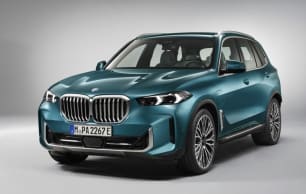While the new Q5 might feel classier, techier and generally more expensive and Q7/Q8-like on the inside, it's pulled off an even more impressive feat in the chassis department, which no doubt owes a lot to the entirely new PPC platform, because it feels more like a powerful Q3 to drive than the Q5 of old.
That's not a comment on interior or load space, it's just that it feels smaller and more spritely on the road. It turns in better, holds its line better and resists gentle understeer right up to the point where you wonder whether your co-driver has lost his mind or is trying to kill you both.
Seriously, the SQ5 can properly get up and boogie in Sport mode (Audi says one of the things it's proudest of with the new car is how much more noticeable the range of difference is between the relaxed, or 'Balanced' and 'Comfort', modes and the more aggressive ones) and you really have to be going beyond sensible to find the edge of grip.
The SQ5's V6 also makes the kind of noises that now sound weirdly wonderful in an Audi, when so many of the new offerings are electric. Choose to shift the gears yourself and this can be a properly involving machine, and quite impressive for an SUV.
What separates it from the kid of fun you could have in its cousin, the previous Porsche Macan with petrol power, is the steering. It's not terrible, and it is sharp, but it just lacks a bit in the feel and muscle department. Being generous you'd say it's easy to drive but you just know that if this had an R badge the steering would be so much better, and closer to Porsche and BMW.
The diesel TDI model does not make glorious noises, and the whines and groans it does make - which seem loud by Audi standards, it's usually very good at quietening its diesels down - do not encourage you to shift gears yourself or drive it in a sporty fashion. It is a workhorse variant, with plenty of torque, and for a certain kind of customer who cares not for sportiness or excitement I'm sure it's a fine option.
One thing I did not expect to be doing on an Audi Q5 launch is clambering up and over a rock strewn mountain on properly rutted and rough gravel tracks, but that was an option here so I took the 2.0 TFSI on the optional off-road adventure and I must say I was both surprised and impressed.
The Q5 is not a mountain goat, or a Land Rover, but despite feeling like I was doing the gardening in a shiny suit, I managed to traverse a track that felt too serious and intense for a soft roader, and did so with ease and in comfort. The air suspension raises the Q5 a full 45mm in Off-road mode, so ground clearance was no problem - nor did I encounter any boulders - but the way the Quattro system dealt with the dirty stuff was impressive.
Overall, I can see that this TFSI model is the sweet spot in the range in terms of value and performance, and it really is all the Q5 you could need. It never feels underpowered, unless you've just stepped out of the SQ5, and you get all the benefits of the chassis and handling upgrades.
Personally, though, I'd have the SQ5 just for the rorty V6 noises alone. It feels like something new, but also the end of something wonderful.

